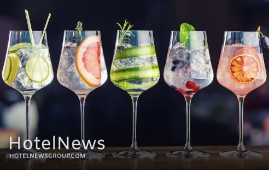
Historic Hotels Around the World you Must Add to your Bucket List Hotel Hill front kesroli - India The 14th century Hill Fort-Kesroli is one of the oldest heritage sites in India The reservation of the rooms of this hotel is done only through the online reservation system, and guests can contact the hotel directly to book the room Only when they want a reservation for the same day. There is no TV in the hotel rooms and there is no room service. In the hotel restaurant, Indian dishes are served along with dishes from other continents to suit most tastes. Also, French, Italian, Chinese and Thai dishes are offered to complete the poolside restaurant buffet. This hotel is an ideal base for visiting the palaces, museums, natural sites and sanctuaries of Sariska and Alwar.
Create: Oct 22, 2022 Edit: Oct 22, 2022 TV
Hotels that we look forward to their exciting opening in 2022 Part 3; Nobu Santorini Hotel- Greece 🇬🇷 The 26th branch of Nobu Hotel in Greece will be opened in Santorini Nubo hotel architect Designed in the traditional whitewashed Cycladic style with minimalistic décor to optimally enhance the dramatic vistas beyond. Nobu Hotel Santorini offers 25 stunning accommodations, all with breathtaking views of the Caldera and the Aegean Sea. It offer a nobu restaurant, luxe spa, fitness center, two level infinity pool and five pool villas Nobu hotel opening this spring is also just 20 minutes from santorini international airport. It also offers a unique blend of Japanese hospitality and stunning Santorini and Whether you’re looking for Nobu Hotel classics or locally packages, explore our offers to find the stay that suits you best.
Create: Oct 22, 2022 Edit: Oct 22, 2022 TV
Hotels that we look forward to their exciting opening in 2022 Part 2 Ritz-Carlton Hotel in NewYork🇺🇸 Ritz-Carlton hotel in Manhattan’s was newly-built from the ground up with 250 guest rooms and 16 luxury penthouse residences. It will feature two new restaurants and a rooftop bar Guest Room Features & Amenities Daily housekeeping service and evening turndown service High-speed wireless Internet access Large flat-screen televisions Same 24 hour laundry services Online Keyless entry via Marriott Bonvoy App Guests can also chill out in the hotel’s signature Ritz-Carlton Spa and Fitness Center. the spa facilities include steam room, sauna, and private lounges to help you escape the hustle and bustle of the city. Visit the modern sensibility of some of the greatest art museums in the world just blocks away
Create: Oct 22, 2022 Edit: Oct 22, 2022 TV
Hotels that we look forward to their exciting opening in 2022 Part 1 CONRAD TULUM RIVIERA MAYA Hotel in Mexico🇲🇽 The hotel is the newest luxury addition to the Hiltons hotels portfolio CONRAD is known for its contemporary style the modern design sets the brand apart from waldorf astoria hotels and symmetry is key element at this particular property hotel. Rooms are arranged in several buildings along the shore line and at the topmost floor, the view of the sea is spectacular The hotel boasts five different restaurant. The main pool bar is the centerpiece of the hotel and in the evening the guests can enjoy drinks while listening to live music or dj performances Guests have multiple options of getting around the hotel they can order a golf car, take a bike or walk along the jungle paths The gym located in the basement of the hotel, yoga and spinning classes are offered throughout the week
Create: Oct 22, 2022 Edit: Oct 22, 2022 TV
Today announced that it has completed an initial closing of the previously announced portfolio acquisition through its existing joint venture with GIC from affiliates of NewcrestImage. The initial closing included 26 of the 27 hotels totaling 3,533 guestrooms, two parking structures, and various financial incentives. The remaining hotel to be acquired is the currently under construction 176-guestroom Canopy by Hilton New Orleans which is nearing completion, and the joint venture expects to close on the acquisition of the hotel during the first quarter 2022 (collectively with the initial closing referred to as the “Transaction”). The total consideration for the Transaction is comprised of $776.5 million, or $209,000 per key, for the 27-hotel portfolio, $24.8 million for the two parking structures, and $20.7 million for the various financial incentives. The Transaction is expected to be immediately accretive to adjusted FFO per share, generate a stabilized net operating income yield of 8.0% to 8.5% including future capital investment and excluding any ancillary joint venture fees earned by Summit, and be leverage neutral to the Company’s balance sheet while preserving existing liquidity of nearly $450 million.
Create: Jan 15, 2022 Edit: Jan 15, 2022 International News
Over 94,000 domestic tourists have stayed in the province during the mentioned time, Jalil Jabari said on Thursday. In nine months, over 16,000 foreign travelers stayed in the province’s accommodation centers and it is estimated that 5,500 foreign tourists will stay in these units in the fourth quarter of the year, the official added. The accommodation centers have generated over 40 job opportunities during the mentioned time as well, he noted. Back in December, Jamshid Hamzehzadeh the head of the Iranian Hoteliers Association announced that following the planned measures, the occupancy rate of the country’s hotels, which had fallen below five percent because of the outbreak of the coronavirus, has reached 45 percent over the past three months. Multiple problems, notably the pandemic, caused a severe impact on the tourism industry, the official explained. Even before the coronavirus outbreak and in 2019, travel was reduced due to heavy rains and flooding across the country, and the hotel industry had to recoup nearly 100 percent of the costs paid for canceled hotel reservations, he added. The Iranian hoteliers have lost 220 trillion rials (about $740 million) over the past two years, he noted. However, some problems have been resolved and the hotels’ condition has improved, he mentioned. Back in October, the official announced that Iranian hotels are ready to receive foreign tourists as the issuance of tourist visas and the flow of foreign tourists from land and air borders would be resumed. Ninety percent of the hotel staff have been vaccinated against the coronavirus, so the hotels are ready to welcome foreign tourists, observing strict health protocols, he said. The main destinations of foreign tourists in Iran are specifically cities such as Mashhad, Qom, Tabriz, Shiraz, Yazd, and Isfahan, and to return to the figure of over eight million incoming tourists before the outbreak of the coronavirus, serious planning is required, the official added. Iraqi tourists will flood the country once the borders open, but attracting tourists from Europe will require some time, he noted. However, he noted that two-thirds of the hotel staff have lost their jobs, he added. Back in September, Hamzehzadeh announced that all employees of accommodation centers across Iran are scheduled to be vaccinated against the coronavirus. “To vaccinate staffs of all accommodation centers, including eco-lodges, apartment hotels, and guest houses, as well as hotels, more coordination with the Ministry of Health is needed,” he added.
Create: Jan 15, 2022 Edit: Jan 15, 2022 Regional News
Wyndham Hotels & Resorts, the world’s largest hotel franchising company with approximately 9,000 hotels across nearly 95 countries, continues to expand its global footprint with its entry into Poland with the 205-room upscale Wyndham Wroclaw Old Town. Managed by Mogotel Hotel Group, a leading hotel operator in the Baltics, the property is expected to open early next month and will be located in the heart of Wroclaw’s city center. One of the largest cities in Western Poland and home to many renowned universities and research centers, Wroclaw combines rich history and charming architecture with a lively cultural scene across its museums, theatres, art galleries and workshops. Perfectly positioned for exploring the central, picturesque Old Town with many attractions and landmarks, the hotel will feature stylish guest rooms, an expansive atrium and a top floor wellness area, with a state of the art fitness room, sauna and steam bath. The hotel will offer a wide range of food and beverage outlets including a gourmet restaurant, a cozy lounge and bar to relax and socialize. Those traveling for business will also have access the hotel’s 11 meeting rooms, which accommodate a total capacity of over 400 attendees. In addition, the hotel is conveniently located just 10 miles from Wroclaw’s International Copernicus Airport. Wyndham Wroclaw Old Town is the latest addition in Wyndham Hotels & Resorts growing portfolio in Europe, including over 350 operational hotels across 30 countries and a development pipeline of over 90 properties. Wyndham hotels in Poland and around the world participate in Wyndham Rewards, the world’s most generous hotel rewards program with more than 50,000 hotels, vacation club resorts and vacation rentals worldwide.
Create: Jan 11, 2022 Edit: Jan 11, 2022 International News
The Kingdom of Saudi Arabia is home to the first hotel in the world to serve and comfort camels. The hotel, called Tatman, includes 120 hotel rooms that provide all services to camels, local media from the gulf country reported on Sunday. According to Arabic daily, English Al-Arabiya, more than 50 people serve in this hotel and they are divided between room services, care, attention, and protection as well. Tatman hotel, provides a 5-star service, including preparing meals for camels, taking care of the appearance and general appearance, in addition to providing hot milk, and making sure to clean and heat the rooms. “This hotel is the first of its kind in the world, but in a different and new style. Everything is available ranging from cleaning rooms to warm air-conditioning,” the official spokesman for the camel club in Saudi Arabia, Muhammad Al-Harbi said in a presentation video.
Create: Jan 11, 2022 Edit: Jan 13, 2022 International News
Menus are an important aspect of the overall presentation of a hotel restaurant. Indeed, a whole book on proper menu design could be written, with inventory arrangements, fonts, graphics, spacing, types of paper, menu backings and all other stylistic concerns outlined as contributing factors for a guest’s overall appreciation of the dining outlet. The pandemic has thrown a wrench in this marketing and sentiment-boosting tool as many customers now expect menus to be accessible on their phones via a QR code. The benefit for the restaurant is certainly there in the form of saving on printing costs, but it’s nonetheless a tradeoff. The concern that we have over the proliferation of QR menus is that they don’t build guest satisfaction as much as their physical antecedents, and this reduced sentiment can halo back onto room revenues in a negative way. Here’s why: paper is palpable. You feel the slight roughness of a thick paper stock, subtly smell the ink, are delighted by the way the room’s lighting creates soft shadows on the page and are soothed by (what we ideally hope that you would use for your establishment) the touch of the leather menu backing on the palm of your hand. Viewing a menu on your phone gives you none of that. Yes, you get graphics, color and the ability to keep the webpage updated in real-time as inventory changes, but everything beyond the straight visuals are lost in the endless scroll of a two-dimensional screen. And building on this notion of scrolling, one critical difference is that a physical menu presents all items together for readers to consider, whereas a responsive webpage (over simply displaying a PDF version of the menu) will usually configure all items into a single column so as to keep everything legible and to avoid lots of pinching. This second drawback is one of perception, where a narrowly focused column on one’s phone can increase the observed length of the menu, resulting in patrons ‘dropping off’ before perusing the entirety of it. We see a similar trend in website readership where it falls precipitously after around the first quarter of an article or page. In sum, on digital-first menus, you have to put your most expensive items (or highest margin) items at the top or they will likely be missed. At this point, with the end of the pandemic still very much a question mark, optionality and fitting your theme is what works best. Paper menus should be readily presented at high-end restaurants so that the theme is congruent and customer satisfaction isn’t deteriorated, while at more casual settings a QR code access may be just fine. While there are both paper and labor costs associated with QR menus, you must still consider the above downsides.
Create: Jan 1, 2022 Edit: Jan 1, 2022 F and B
After years marred by a global public health crisis, many of us are lapping up in-person social gatherings with friends, family and colleagues. Morning catch-ups over coffee, afterwork happy hour at the favorite waterhole or weekend drinks in town had mostly been replaced with coffees-to-go, virtual apéros, or alfresco drinking in winter like in summer. Consumers have become today their own baristas and bartenders, imbibing alone at home or at a distance outside. So how, and with what, will we quench our thirst? Here is EHL’s selection of the top drink trends in 2022. In this pandemic-era, there is no doubt that the megatrends for the new year will center around healthier and ‘cleaner’, more sustainable, premium and socially responsible products in line with the mantras – good for me, good for the planet – and quality over quantity. With movements like mindful drinking and “sober curious” gaining popularity, research indicates that alcohol consumption has declined with younger generations drinking less as they show greater interest in holistic wellness and health. And the beverage industry has been paying attention to these shifts in concern, consciousness and habits. Functional and healthy beverages are on the rise, and no and low alcohol ready-to-drink offerings from North America to Europe and Asia-Pacific have boomed as they prove to be both a more convenient and ‘safer’ option in a world still plagued by COVID-19 measures and barrier gestures. But globally, we’re seeing an array of interesting new product developments, packaging innovations and surprising mergers and acquisitions with the lines between the health movement, the low- and no- alcoholic category and the wider drinks industry becoming increasingly blurred. Beyond these general tendencies, we take a look at six particular drink trends for the year ahead. 1. CBD-infused relaxation drinks For those of us who frequent trendy bars, a controversial yet very 2022 new trend has found its way onto cocktail menus in only the most avant-garde of venues. 2. The bubble tea craze goes global Despite being invented in the 1980s, bubble tea is set to see its popularity soar to new heights. From the US to Germany, China to Brazil, the bubble tea industry is going global with its market expected to grow by almost $2 billion to reach $4.3 billion by 2027. The refreshing Taiwanese tea-based drink with its tapioca or fruit jelly ‘bubbles’ is appealing to health-conscious individuals enjoying the healthier variants low in sugar, with organic soya milk, green tea or fruity mixes as well as a younger generation seduced by its 200 or so different flavor combinations and even more customizable options making for a truly unique, tasty and fun drink. 3. Fermented drinks as a health-booster Increased awareness on the importance of fueling our body with quality and nutritious food and drink is driving a rapid growth in fermented beverages, occupying a significant portion within the functional and healthy drinks category. It’s estimated that probiotic beverages are expected to achieve over $77 billion in sales by 2025, almost double the revenue generated worldwide in 2018. While kombucha has been topping the leader board for some years, it’s now got some serious competition. Water kefir, with its more diverse probiotic strains shown to help boost the immune system and aid digestion, is gaining momentum and creeping into the mainstream. As is the fermented Mexican soda Tepache – another healthy, flavorsome, sustainable alternative to kombucha. While not new in itself, it has promising prospects in this ‘health-conscious’ era, but hey, it’s just a gut feeling! 4. Wines and champagnes with star power Celebrity beverage endorsements are nothing new. Think George Clooney and Nespresso, Jennifer Aniston and Smart Water, or countless sporting stars endorsing energy drinks. But expect to see more and more vineyards and champagne houses partnering with big names to capitalize on their glamorous images and extend their respective brand portfolios. After John Legend, Kylie Minogue or Brad Pitt, Cameron Diaz is the latest celebrity to venture into the wine business with her “clean” wines. The range comprises of an organic and vegan French rosé and Spanish white with no added sugar, with Diaz tapping into both the wellness trend and that of the growing ‘thirst’ for ‘pink’ wine. Such partnerships are also strategic in helping introduce wines and champagnes to new consumers, in particular millennial drinkers drawn to celebrity and wellness lifestyles, and who aren’t impartial to the Instagrammable aesthetic of a fizzy or rose-tinted drink. 5. Boxed wine as a sustainable (and sanitary) choice Did you know that during the COVID-19 pandemic, bag-in-a-box wine was the supermarket alcoholic “go-to” beverage? The draw? Beyond the product within the bag, boxed wine is easier to store, it better preserves open wine, and is proving a more hygienic and sustainable option, in particular for restaurants. With each three-liter box generating about half the carbon dioxide emissions to that of a glass bottle, boxed wine is also cheaper to transport, stock and more environmentally-friendly. Something that even the more premium wine houses can’t ignore. While wine connoisseurs may jump to the conclusion that boxed wine equates to poor quality, industry experts are suggesting that that’s changing, and fast, as sales are forecast to continue surging around the world in 2022. 6. Canned cocktails with premium products While some may have enjoyed following online mixology tutorials to create their own home-made cocktails, many long for the days when original creations were served ready-made for immediate consumption. Well, spirit brands and hotel chains like the Marriott have wasted no time to offer the perfect solution and create a variety of delicious, bartender-quality, ready-to-drink cocktails in cans. Tipped to be the hottest trend in the alcoholic beverage space in 2021, the development of prepared cocktails-to-go has, according to Nielsen Premium Panel data, accelerated 171% in 2020, and shows no signs of slowing down in 2022. With high-quality ingredients, authentic flavors, options between low-calorie, sugar and alcohol or premium spirits, and convenient and sanitary packaging – grab-and-go cocktails are here to stay. 7. Spiked sodas and alcohol-free beers and spirits With interest in low and no alcohol by volume (ABV) drinks skyrocketing over the last few years, more and more people are looking for a middle ground between tee-total and drinker, between functional and indulgent, between high-quality and convenience. Consequently, low and non-alcoholic beverages are flooding the market and is the space to watch. From non-alcoholic beers and premium mocktails by spirit brands to the boom of hard seltzers now spilling over into hard coffees and kombucha – consumers are going to be spoilt for choice. Whether it’s wanting something with less sugar and alcohol, with premium products, looking for a slight ‘kick’ in traditional non-alcoholic beverages or an alternative to beer, this growing category ensures there’s something for every taste bud and type of drinker. Drink trends 2022: a toast to good health As we look to turn our backs on 2021, and raise our glasses to a new year, the question still lingers as to whether the drinking habits developed in a COVID-era will prevail in a post-pandemic world. While there is still so much uncertainty, what is clear is that the increasing consumer interest in health, wellness and mindfulness is shaping the beverage industry as a whole as it seeks to quench this thirst for holistic balance. For being able to choose alcohol-free beverages without having to sacrifice flavors, fizz or authenticity. For indulging in a drink without having to abstain completely. For a return to more simplicity with natural and ‘clean’ products. For drinking less in quantity but better in quality.
Create: Jan 1, 2022 Edit: Jan 1, 2022 Coffee Shop
